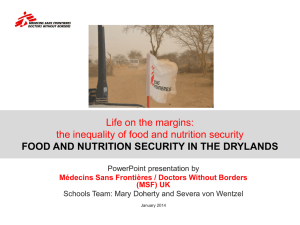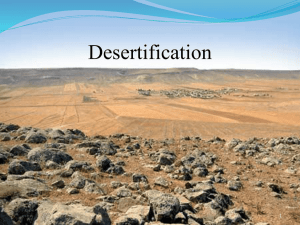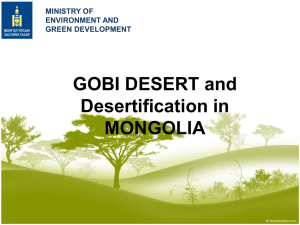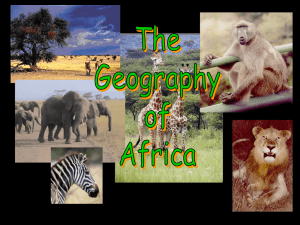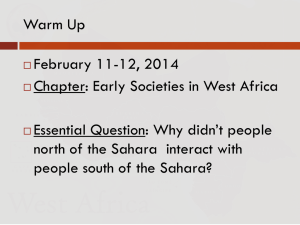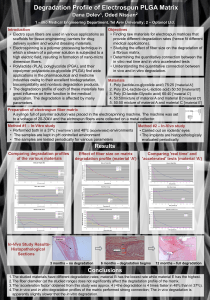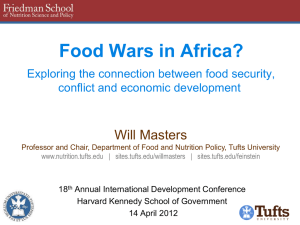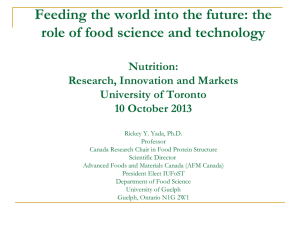Action for students
advertisement
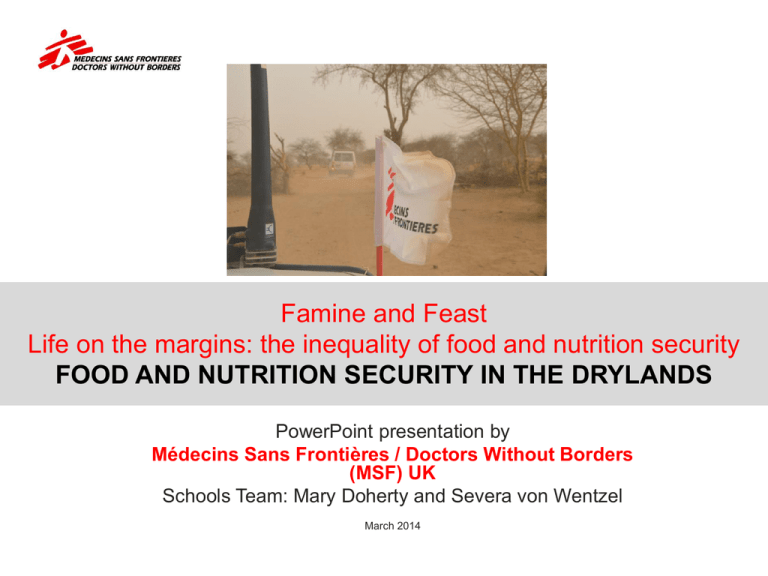
Famine and Feast Life on the margins: the inequality of food and nutrition security FOOD AND NUTRITION SECURITY IN THE DRYLANDS PowerPoint presentation by Médecins Sans Frontières / Doctors Without Borders (MSF) UK Schools Team: Mary Doherty and Severa von Wentzel March 2014 LIFE ON THE MARGINS: DRYLANDS, DESERTIFICATION AND DEGRADATION Distribution of drylands Action for students: What is the impact on Tradewinds of continentality and topography on Tradewinds and how does this affect aridity? Drylands mostly occur because of one or more of the following factors: • • • • Atmospheric stability – Either side of the equator solar heating is greatest. Given global circulation patters, subtropics are generally warm arid zones where precipitation is scarce and irregular and which are surrounded by narrow semi-arid regions. Seasonal monsoon offers relief. Continentality – rain fails to penetrate deep into across large landmasses deep into the continent where the distance from marine or other sources of moisture is great (e.g., Central Asia) Topographic effects – Mountain ranges create rain shadows and makes the air laden with moisture rise so that it does not reach certain regions (e.g., Argentinian drylands) Cold ocean currents – Cold ocean currents reinforce low rates of sea-surface evaporation, low precipitation and low temperature range. They flow from the Poles to the Equator, affecting the western coastal margins of South America, southern Africa (e.g., Namib Desert) and Australia Source http://homepages.abdn.ac.uk/c.p.north/pages/DrylandRivers/whatare/whatare1.php Lower human well-being in the drylands • According to the Millennium Assessment, the human well-being of dryland peoples is generally lower than that of people in other ecological systems (e.g., highest infant mortality rates are highest in drylands and lowest gross national product (GNP) per capita). By implication, populations in the drylands experience comparatively low levels of well-being, among the most acute food insecurity problems, least technological advancement. • Droughts and desertification threaten the livelihoods and wellbeing of more than 1.2 billion people in 110 countries, the poorest and most marginalised, who live in vulnerable areas in around 100 countries (e.g., Horn of Africa, Australia, China, Mongolia, Gobi desert, Aral Sea, The Sahel, Haiti, China, Zimbabwe) • Droughts and loss of land are the main reasons why people migrate from drylands to others areas. Source: UN Food Security - http://www.un-foodsecurity.org/node/709; Reviewing the link between desertification and food insecurity http://link.springer.com/content/pdf/10.1007%2Fs12571-009-0016-0.pdf; Edexcel 6GE04 Unit 3 Life on the Margins: the food supply problem specification http://www.edexcel.com/migrationdocuments/GCE%20New%20GCE/UA024843%20GCE%20Geography%20Issue%203%20210510.pdf; http://www.un.org/en/events/desertification_decade/whynow.shtml Populations in different dryland subtypes Population of developing and industrial countries in different dryland subtypes and population of industrial countries in each dryland subtype as percentage of total global dryland population (CIESIN 2004) Source: http://passthrough.fwnotify.net/download/341043/http://www.unep.org/maweb/documents/docu ment.291.aspx.pdf; http://204.200.211.31/contents/file/Poverty-and-theDrylands-Challenge-Paper.pdf Dryland subtype and socioeconomic status: The SAHEL: Starved for attention 195 millions stories of malnutrition. Rewrite the story. Do you know where the Sahel is? The Sahel is the vast stretch of dry land, a semi-arid region on the Southern fringe of the Sahara desert extending from the Atlantic Ocean to the West to the Indian ocean in the East. The Sahel is the northern part of Sub-Saharan Africa along with the Horn of Africa. Action for students: 1. With your teacher and fellow students, discuss how and what you should capture in notes as the starting point for your case study on the Sahel and do so. 2. Watch each of these videos as the starting point for understanding the difficulties and challenges in the Sahel. – OCHA Films. Sahel: a crisis of food security and malnutrition http://www.youtube.com/watch?v=qQ9IKAodknA – MSF Malnutrition in the Sahel Strip http://www.youtube.com/watch?v=nKQkp1qGFp0; – On the MSF malnutrition page, hover of the photo to find video on treating malnutrition in Chad http://www.msf.org.uk/malnutrition – MSF Starved for attention on poverty among subsistence farmers “A mother’s Devotion in Burkina Faso” http://www.starvedforattention.org/ Image Sahel: http://www.bing.com/images/search?q=the+sahel+&form=CMNMHP&mkt=engb&qs=n&sk=&pc=CMDTDF#view=detail&id=206860C9B7FE686DBC9B7A42A3 510EBCF3EB8BE9&selectedIndex=6 Sahel • • • • • • • • One of the poorest and environmentally most degraded and depleted areas in the world. Population density (number of inhabitants per sq km) low in the semi-arid regions of the Sahel, but only a small part of the Sahel is suitable for ecological and economically sound agriculture. Population pressure on the Sahel is increasing and has led to reduced availability of communal land, low crop yields, the breakdown of the fallow system. Inconsistent climate with the effect of intermittent drought made worse if they follow wet periods, which allowed for farming of borderlands crops that then fail during drought. Variable rainfall: after years of heavy rainfall, years of drought. Very food insecure region due to a range of geographic, demographic and economic issues. Food insecurity has been consistently worsening over past decades. Food shortages and famines have also played a part in outbreaks of conflicts in Sudan (Darfur). Source: Lifland, Amy. Starvation in the Sahel http://hir.harvard.edu/crafting-the-city/starvation-in-the-sahel Sahel countries Action for students: on an outline map of Africa label the Sahel, Sub-Saharan Africa, (parts of) countries, main cities, equator, Sahara desert, Sudanian Savannas, Atlantic and Red Sea. Add a key. You can use atlases or Google Earth/maps. The shaded zone represents the approximate area of the Sahel based on 20 C annual rainfall with a 200mm northern limit and a 600mm southern one. Dryland systems in the Sahel Shifting Sahel The Sahel is the interface between • Arid desert and lush sub-tropical environments. • Nomadic herders and settled agriculturists Climate change is shifting the whole Sahel south, so that the nomads are pushing south into the settled agricultural lands. This has been a key issue in Darfur, for example. The harshness of the environment, lack of resources and the pressures between nomads and settled agriculture leads to tensions and conflict. Further info: Article on how the Sahel is defined by its climate: http://www.angelfire.com/mac/egmatthews/worldinfo/africa/sahel.html Food insecurity factors in the drylands According to the UN Convention to Combat Desertification Internal drivers: Worsening factors: • • • • • High prices on the commodity market • Lack of investment • Governance issues and land grabbing • Lack of regional cooperation and conflicts • Migration • Climate change • • • • Inherent poor soil Water scarcity Land degradation Low growth on agricultural yields Population growth Poverty Gender Malnutrition Further info and Source: http://www.unccd.int/en/programmes/ThematicPriorities/Food-Sec/Pages/Internal-factors.aspx The Sahel: Permanent emergency Recurrent and cyclical crises Malnutrition rates always at or above warning level Spikes of malnutrition cases during hunger season (between July and September depending on country) Further info: Malnutrition in the Sahel: One Million children treated -- What’s next? http://www.doctorswithoutborders.org/publications/reports/2012/Sahel_Briefing_Document .pdf Welthungerhilfe on Sahel, climate change and desertification http://www.youtube.com/watch?v=xejky5o-3Qk Guardian on “Sahel hunger crisis risks being another example of too little, too late” http://www.guardian.co.uk/global-development/povertymatters/2012/jun/21/sahel-hunger-crisis-little-late?intcmp=122 MAP OF MSF’S PEDIATRIC AND NUTRITIONAL ACTIVITIES IN THE WESTERN SAHEL To give you an idea of the scale of activities– here are the operations run by one large humanitarian organisation. MSF runs regular programs to prevent malnutrition and treat other childhood diseases in the Western Sahel. Map: http://www.doctorswithoutborders.org/publications/reports/2012/Sahel_Briefing_Document.pdf Image: http://www.doctorswithoutborders.org/images/2010/5558639-Sudan.jpg Image and source: Center for International Earth Sciences Network, “Migration in Risk-Prone Areas” http://blogs.ei.columbia.edu/2013/02/04/migration-in-risk-prone-areas/ contents Migration in the drylands In low income countries the move to urban areas both inside and outside dryland areas was due mostly to climate variability (especially frequency of droughts) and the difficulty of making a living from traditional, rain-fed forms of agriculture and pastoralism on these marginal lands. (Definition: http://www.fao.org/wairdocs/tac/x5784e/x5784e05.htm) Growing urban poverty: The Sahel • • • • • • The Sahel is not only rural – a common misconception. The region with a population of about 50 million people has experienced unprecedented urban population explosion and most future growth is set to occur in cities. Urban environments are more heterogeneous than rural ones. Many of the newcomers are from most disadvantaged rural backgrounds, and thus have fewest resources to help them cope in cities. Economic decline or slowdown (stagnating or declining gross domestic product annually),results in urban economies strained with limited ability of local and national governments to provide minimally decent living conditions, basic social services and livelihood opportunities. Overcrowded and extremely unsanitary slums and shantytowns which leads to epidemics and outbreaks of diseases – pockets of severe deprivation, poverty and concentration of ill health. Health care systems affecting health and mortality tend to be better for urban than rural populations. However, overall the rural-urban gap in child health is narrowing due to increase in urban malnutrition, and health and nutritional outcomes for poor urban children can be worse in cities. Source: Lifland, Amy. Starvation in the Sahel http://hir.harvard.edu/crafting-the-city/starvation-in-the-sahel Urban-Rural Differentials in Child Malnutrition Trends and Socioeconomic Correlates in Sub-Saharan Africa http://irnegotiation0708.pbworks.com/f/download+malnutrit.pdf Growing urban poverty: Mali, Chad, Burkino Faso Action for students: How do growing poverty and a breakdown of the country’s social fabric relate to growing urban settlements and malnutrition in the Sahel? • Bamako, Mali http://www.irinnews.org/report/76375/maliurbanisation-fuelling-begging-on-streets-of-capital • BBC Photo journal on Chad urban migrant story http://news.bbc.co.uk/1/shared/spl/hi/picture_gallery/ 06/africa_chad_urban_migrant0s_story/html/1.stm • Burkino Faso’s urban hunger http://www.irinnews.org/report/85854/burkina-fasohunger-stings-worse-in-the-city What do the slums look like in the Sahel? More on Chad’s N’Djamena, for example, pictured here: http://tripwow.tripadvisor.com/slideshow/chad/ndjamena.html Image: http://tchadonline.com/index.php/monde-ndjamena-vitrine-duneant/ Climate change in arid and semi-arid areas “650 million people now live in arid or semi-arid areas where floods and droughts and price shocks are expected to have the most impact. The recent crises in the Horn of Africa and Sahel may be becoming the new normal. Droughts are expected to become more frequent....Climate change is a creeping disaster.” - UN's World Food Programme climate change office, http://www.theguardian.com/environment/2013/apr/13/climate-change-threat-food-supplies?INTCMP=SRCH Action for students: Climate change in arid and semi-arid areas poses the greatest threat to the food security of people living in these areas. Discuss. Write a report with that title, using the – – – – • Examiners Report as a guide Resources below Maps which follow in this section of the presentation and Other resources you select On climate change: Guardian article http://www.guardian.co.uk/environment/2013/apr/13/climatechange-threat-food-supplies?INTCMP=SRCH • • • Slideshow on climate change: http://www.rockefellerfoundation.org/impacts-adaptations/ Video on work to build resilience: http://www.wfp.org/climate-change Hunger and Climate Change (cover pictured on right and following two slides) and note impact by area and initiatives http://documents.wfp.org/stellent/groups/public/documents/communications/wfp227909.pdf • Climate change and Food Fact Sheet Action Aid Effect of global warming on arid and semi-arid areas in Africa Global warming causes particular difficulties across Africa, an especially vulnerable continent given its large dependence on rain-fed agriculture. Africa is warming steadily with temperatures as a whole 0.5 degrees warmer than in 1900. The greatest increases (double the global increase) have been recorded in the interior. • Droughts are more common such that arid and semi-arid areas are becoming even drier. • Overall rainfall is decreasing with more reductions likely in the Sahel. • Rainy seasons are less reliable and rains more localised. Photo: Juan Carlos Tomasi/MSF Digby, Bob et al, “AS Geography for Edexcel”, Oxford: Oxford University Press, 2008 The Sahel and climate change Image: http://www.oecd.org/swac/otherfocusareas/securityimplicationsofc limatechangeinthesahel.htm Image: http://www.oecd.org/swac/otherfocusareas/securityimplicationsofclimatechang einthesahel.htm The Sahel climate hotspots livelihood systems Action for students: Make a note in your folder of the climate hotspots and how they may affect the livelihood systems. Also consider the impact of other human and natural factors in the hotspots. Source: http://www.oecd.org/swac/otherfocusareas/securityimpl icationsofclimatechangeinthesahel.htm SCARCITY, DEGRADATION AND DESERTIFICATION Water inequality Access to and use of water is a good example of global inequality. The health and well-being of communities depends on safe and lasting water supplies and its associated knowledge and practices. Inadequate access to safe water is a problem suffered by about 1.1 billion people suffer, and lack of access to basic sanitation by about 2.6 billion. Water scarcity, unsafe drinking water, inadequate sanitation and poor hygiene can lead to sickness, malnutrition and death. About 2.2 million people die from these each year, mostly children. Source: http://www.actionagainsthunger.org.uk/what-we-do/programme-areas/water-and-sanitation/?gclid=CNL61Oz-ir4CFc6WtAodGxIAeg Global water consumption The world supply of freshwater cannot be increased. The number of people becoming dependent on limited supplies of freshwater that are becoming more polluted is rising. Action for students: What is a water footprint? What is the relation between consumption and water use? http://www.waterfootprint.org/?page= files/NationalWaterFootprint Source: http://theresilientearth.com/?q=content/watering-down-biofuels; http://infranetlab.org/drupal7/sites/default/files/blog/wpcontent/uploads/2008/12/08_12_01_cloud_seeding03.jpg; Source: http://www.unccd.int/en/programmes/Thematic-Priorities/CC/Pages/default.aspx; http://www.un.org/en/events/desertification_decade/whynow.shtml Water consumption “Falling water tables are widespread, resulting in serious water shortages and salt intrusion in coastal areas. Contamination of drinking water and nitrate and heavy metal pollution of rivers, lakes and reservoirs are common problems throughout the world. “ (UNCCD) Source: http://theresilientearth.com/?q=content/watering-down-biofuels; http://infranetlab.org/drupal7/sites/default/files/blog/wpcontent/uploads/2008/12/08_12_01_cloud_seeding03.jpg; Source: http://www.unccd.int/en/programmes/ThematicPriorities/CC/Pages/default.aspx; http://www.un.org/en/events/desertification_decade/whynow.shtml contents Resource constraints affect people in drylands most Like food security, water security is becoming a major national and regional priority in many areas of the world. The global water crisis is exacerbated by drought, land degradation, desertification and pollution. Water scarcity, the gap between its demand and supply is likely to be one of the main factors limiting food production. Water scarcity increases with an increase in aridity, so it is highest in the drylands. Most of the 1-2 billion people affected are in the drylands (UNCCD). Each person requires a minimum of 2,000 cubic metres of water per year for well-being, but drylands people have 1,300 cubic metres only with availability projected to decrease. Population increase, land use, land cover change and global climate change are likely to accelerate existing water shortages and lead to a decline in biological production in the drylands. “Under the climate change scenario, nearly half of the world's population in 2030 will be living in areas of high water stress. In some arid and semi-arid areas, it will displace up to between 24 million and 700 million people.”(UN) . Source: http://www.unccd.int/en/programmes/Thematic-Priorities/CC/Pages/default.aspx; Water insecurity: Role of technology Water is arguably as important to food production as land. “Natural” picture of the human water security threat level Adjusted map takes into account investment in technology. Use of technology can entail risks and damage to the environment. Cartograms: http://www.viewsoftheworld.net/?p=896 Maplecroft water stress index Further info: Water and Food Security Faqs UNWater http://www.unwater.org/worldwaterday/faqs.html Climate change fact sheet http://www.actionaid.org.uk/doc_lib/schools_climate_chan ge_fact_sheet.pdf Global water Outlook to 2025; the State of the World’s Land and Water Resources for Food and Agriculture, http://www.fao.org/nr/water/docs/SOLAW_EX_SUMM_W EB_EN.pdf http://www.ifpri.org/sites/default/files/pubs/pubs/fpr/fprwate r2025.pdf Source: http://maplecroft.com/portfolio/new-analysis/2012/05/10/unsustainable-water-use-threatens-agriculture-business-and-populations-china-indiapakistan-south-africa-and-usa-global-study/; Source: IWMI 2000 Global Water Scarcity Study 2000; http://passthrough.fwnotify.net/download/341043/http://www.unep.org/maweb/documents/document.291.aspx.pdf Land availability Land and land-based sources are central to the global economy. • Population is increasing and land per person is decreasing. Currently there is 0.72 hectares per person of agricultural land, which is projected to drop to below 0.7 hectares by 2016 without taking into account land degradation and loss of current agricultural land (UNPD 2011) • World globalisation and increasing interdependence mean that effect and consequences of the loss of arable land to others uses will affect us all. • Due to climate change and associated impacts such as sea-level rise, urbanisation, land protected for biodiversity and unsustainable land management, the amount of available land for agriculture is unlikely to increase. • “Many of the countries not growing enough food to feed themselves possess the largest remaining reservoirs of untapped agricultural resources. Latin America and subSaharan Africa have much unused land although its quality and quantity vary greatly from nation to nation and much of it is ecologically vulnerable. The Soviet Union and parts of North America have significant amounts of frontier land suitable for agriculture; only Asia and Europe are truly land-starved.” (UN Documents, Our Common Future http://www.un-documents.net/ocf-05.htm) Source: UNEP “The end to cheap oil: a threat to food security and an incentive to reduce fossil fuels in agriculture”, http://na.unep.net/geas/getuneppagewith articleidscript.php?article_id=81; Land uses in drylands The drylands account for up to 44% of the world’s cultivated systems. Used traditionally for livestock, they are being converted more and more into cropland (land used for cultivating crops). Supporting 50% of the world’s livestock, rangelands – vast natural landscapes - are habitats for wildlife. Source: http://www.eoearth.org/view/article/152297/; http://www.un.org/en/events/desertification_decade/whynow.shtml A composite term, land degradation describes the sustained loss in the quality and the productive capacity of the land (FAO). Land depletion and degradation Approximately 6 million square kilometres (about 10%) of drylands are now degraded due to unsustainable land and water use and the impacts of climate. Dryland degradation subtracts an estimated 4–8% of developing countries’ national gross domestic product (GDP) each year.(UNCCD) / Image: http://www.farmingfirst.org/green-economy “Short-sighted policies are leading to degradation of the agricultural resource base on almost every continent: soil erosion in North America: soil acidification in Europe; deforestation and desertification in Asia. Africa, and Latin America; and waste and pollution of water almost everywhere. Within 40-70 years, global warming may cause the flooding of important coastal production areas. Some of these effects arise from trends in energy use and industrial production. Some arise from the pressure of population on limited resources. But agricultural policies emphasizing increased production at the expense of environmental considerations have also contributed greatly to this deterioration.” (UN Documents, Our Common Future http://www.un-documents.net/ocf-05.htm) Causes of dryland degradation LAND DEGRADATION WALL Direct drivers of land degradation are mostly climatic, especially low soil moisture, rainfall patterns and evaporation. Indirect drivers are mostly human: the debt crisis, growing poverty, poor people’s lack of access to resources / technology used, global and local market trends, socio-political dynamics and food insecurity. These drive drylands’ loss of productive capacity and increase destruction. As the land on which rural communities depend becomes increasingly scarce, competition increases. More pressure on existing land to grow food can lead to growing desertification Source: Stocking and Murnhanagan (2000) found on http://www.fao.org/docrep/008/y5744e/y5744e08.htm; http://article.sapub.org/10.5923.j.ijaf.20130302.03.html; Source: UN Food Security - http://www.un-foodsecurity.org/node/709; Reviewing the link between desertification and food insecurity - http://link.springer.com/content/pdf/10.1007%2Fs12571-009-0016-0.pdf; Edexcel 6GE04 Unit 3 Life on the Margins: the food supply problem specification http://www.edexcel.com/migrationdocuments/GCE%20New%20GCE/UA024843%20GCE%20Geography%20Issue%203%20210510.pdf; http://www.un.org/en/events/desertification_decade/whynow.shtml; http://www.un.org/en/events/desertification_decade/whynow.shtml Drought risk Action for students: How do human factors contribute to the impacts of drought? Explain the interrelationship between drought, land degradation and desertification and climate change and note or sketch this in your folder. Give examples of extreme weather affecting major food basket regions events and their likely link to climate change. Source: Map http://www.careclimatechange.org/files/reports/Implications_drought_risk_world_7.jpg; Source: UN Food Security - http://www.unfoodsecurity.org/node/709; Reviewing the link between desertification and food insecurity - http://link.springer.com/content/pdf/10.1007%2Fs12571009-0016-0.pdf; Edexcel 6GE04 Unit 3 Life on the Margins: the food supply problem specification http://www.edexcel.com/migrationdocuments/GCE%20New%20GCE/UA024843%20GCE%20Geography%20Issue%203%20210510.pdf; http://passthrough.fw-notify.net/download/341043/http://www.unep.org/maweb/documents/document.291.aspx.pdf Droughts in the Sahel • • • • Droughts, natural phenomena, and subsequent famines in 1970s and 1980s. Land degradation ensued and lead to further reduce rainfall. More recently, another contributing factor to the droughts, it is thought, has been the warming of the Indian Ocean. In a vicious cycle of physical and human factors, droughts lead to lower productivity and lower vegetation cover, reduced water recycling and monsoon circulation, decreased precipitation, soil erosion and further loss of productivity. The droughts, increasing population density and reduced vegetation cover can also drive human unsustainable land use practices that exasperate soil degradation, dust and wind erosion. Source: http://www.eoearth.org/view/article/152297/ Vicious cycle of land degradation Action for students: With reference to the diagram to the left and the quote below, explain how there can be a vicious cycle of degradation. You may also reference IFAD’s “Combating Environmental Degradation” http://www.ifad.org/events/past/hunger/envir.html Source: http://orbisunumlana.files.wordpress.com/2012/03/v9909e011.jpg Impacts of land degradation Source: www.unep.org/geo/geo4/report/03_land.pdf Desertification The process of “Desertification is caused by a complex mix of climatic and human effects. The human effects, over which we have more control, include the rapid growth of both human and animal populations, detrimental land use practices (especially deforestation), adverse terms of trade, and civil strife. The cultivation of cash crops on unsuitable rangelands has forced herders and their cattle onto marginal lands. The unfavourable international terms of trade for primary products and the policies of aid donors have reinforced pressures to encourage increasing cash-crop production at any cost.” (UN Documents, Our Common Future - http://www.undocuments.net/ocf-05.htm) Dire Kiltu, Arsi, Ethiopia. Kids playing are struck by a burst of wind – symptom of desertification and consequential drought. Photo: GUGHI FASSINO / GRAZIA NERI. Action for students: Affecting almost every region of the globe, desertification is most destructive to the drylands of South America, Asia, and Africa. Quantify desertification around the globe by region. Map showing risk of human induced desertification “Desertification refers to the land degradation in arid, semi-arid and subhumid areas resulting from various factors, including climatic variations and human activities. When land degradation happens in the world's drylands, it often creates desert-like conditions. Globally, 24% of the land is degrading. About 1.5 billion people directly depend on these degrading areas. Nearly 20% of the degrading land is cropland, and 20-25%, rangeland.” Source: http://soils.usda.gov/use/worldsoils/papers/fig3-desrisk.jpg http://www.un.org/en/events/dese rtification_decade/whynow.shtml Causes of desertification • The Millennium Ecosystem Assessment identifies the cause as the result of a longterm failure to balance human demand for ecosystem services and the amount the ecosystem can supply • Mismanagement and politics are often root causes • Climate change is adding more complexity Source: Edexcel Student Guide Unit 4, Option 3; http://www.edexcel.com/migrationdocuments/GCE%20New %20GCE/Unit-4-Option-3-Life-on-the-margins-Foodsupply-problem-final.ppt. Impacts of desertification “Desertification and poverty are closely and directly linked to each other. While desertification can lead to famine, malnutrition, under-nourishment, epidemics, economic and social instability and migrations, these can, in turn, cause or increase desertification. In addition, poverty contributes to land degradation in drylands by inducing poor women and men to exploit the natural resource base in an unsustainable manner. Degradation then lowers productivity and incomes, thereby increasing poverty and further exacerbating pressure on the natural resource base”(http://passthrough.fwnotify.net/download/341043/http://www.unep.org/maweb/documents/document.291.aspx.pdf) Source: www.unep.org/geo/geo4/report/03_land.pdf Sahel desertification Some definitions Desertification: “land degradation in arid, semi arid and dry sub humid areas resulting from various factors, including climatic variations and human activities” (UNCCD glossary, http://www.unccd.int/en/resources/Library/Pages/Glo ssary.aspx) The process of salination is brought on by the increased concentration of salts in soil that are soluble. Salination is a problem linked to desertification Action for students: Use the four resources here to Research :Why is the Sahel spreading? 1. 2. 3. 4. “Desertification of arid lands”: http://www.ciesin.columbia.edu/docs/002-193/002193.html Extensive education resources on desertification: http://www.unesco.org/mab/doc/ekocd/index_learn ing.html Desertification in the Sahel: http://oceanworld.tamu.edu/resources/environmen t-book/desertificationinsahel.html FAO “The African Wall” http://www.fao.org/docrep/016/ap603e/ap603e.pdf Land degradation: diminished or lost biological or economic productivity of drylands. Drought: an extended period of drier weather than is usual (in the Sahel this can last for more than 10 years) Desert: A dry area, hot or cold, where total annual precipitation is less than 250 mm. Usually treeless Source: Sahel case study http://learn.cvcweb.net/mod/resource/view.php?id=6305; Image: http://legalplanet.wordpress.com/2010/06/21/africa-is-dying Water for Sahel Over-farming and over-grazing; shift away from nomadic to sedentary lifestyle and conflict have contributed to desertification. • For example, 250000 refugees from Sudan in Eastern Chad put strain on environment by gathering firewood Source: Lifland, Amy. Starvation in the Sahel http://hir.harvard.edu/crafting-the-city/starvation-in-the-sahel MSF provides water in the Sahel Photos: MSF Demographic and natural resource links Action for students: Refer to the diagram to the right, consider how food issues are affected by: • Poverty • Problems of low agricultural productivity • Natural resource degradation and desertification And can lead to conflict, migration and negative environmental impacts and nutrition emergencies Source: UNFPA 1991 RESPONSES AND MANAGEMENT Responses needed to deal with desertification “United Nations Decade for Deserts and the Fight Against Desertification, which runs from January 2010 to December 2020 to promote action that will protect the drylands. The Decade is an opportunity to make critical changes to secure the long-term ability of drylands to provide value for humanity's well being.” (http://unddd.unccd.int/Pages/Purpose.aspx) Source: UNEP Land www.unep.org/geo/geo4/report/03_land.pdf Resilience and capacity building in the Sahel Action for students: With reference to the following two slides, explain how can resilience (ability to withstand shock) and capacity building* address the cycles of crises brought on by drought, poor harvests, inadequate irrigation, high food prices, inadequate grain reserves and chronic regional insecurity. Keep climate change and sustainability in mind. – SahelNOW definition of resilience in the e-book “Resilience in Simple Terms”: – http://sahelnow.blogspot.co.uk/2012/12/partners-moving-towards-common-roadmap.html#more The Guardian “How to build resilience in the Sahel”: http://www.guardian.co.uk/globaldevelopment/poverty-matters/2013/feb/27/how-build-resilience-sahel – – FAO The Sahel Crisis: http://www.fao.org/crisis/sahel/en/ Reliefweb on resilience building in the Sahel: http://reliefweb.int/report/mali/common-un-approachresilience-building-sahel-september-2012 – MSF Dialogue on Resilience in humanitarian and development work: http://www.msf.org.uk/sites/uk/files/Dialogue_12_Resilience_FINAL_201303211222.pdf building “conceptual approach to development that focuses on understanding the obstacles that inhibit people, governments, international organizations and non-governmental organizations from realizing their developmental goals while enhancing the abilities that will allow them to achieve measurable and sustainable results.” (Wikipedia) * Capacity Source: The Economist, “The Sahel: Hungry again”, July 7th 2012, p. 53; UNCCD 2nd Climatic Conference 2013, http://2sc.unccd.int/fileadmin/unccd/upload/documents/Background_documents/Background_Document_web3.pdf Key priorities of gender-responsive action in the drylands How does gender inequality link and impact on the problems in the Sahel? Further info: FAO “Gender and Sustainable Development in Drylands: an Analysis of Field Experiences” http://www.fao.org/docrep/005/j0086e /j0086e00.HTM Promote Women’s empowerment (Sun Movement Roadmap 2012) “Women’s traditional roles (e.g. collecting water, growing food, etc.) are particularly crucial in drylands in terms of natural resource management and food security. Men have usually been responsible for decision-making and planning of farming activities, but they increasingly leave the degraded areas to look for jobs in urban areas, leaving women to assume new roles and responsibilities on the farm. In such a changing context, it is fundamental to be aware of the obstacles hindering full participation of disadvantaged groups, including women.”(http://www.fao.org/docrep/005/j0086e/j0086e00.HTM) TEACHER RESOURCE SLIDES Risks associated with agricultural production systems Global distribution of risks associated with agricultural production systems – a systematic overview Further info: On the environmental food crisis: • http://www.grida.no/files/publications/FoodCrisis_lores.pdf • http://www.fao.org/nr/water/docs/SOLAW_EX_SUMM_WEB_EN.pdf *Source: Thomas F. Homer Dixon Environment, Scarcity, and Violence http://press.princeton.edu/titles/6640.html; Image: http://www.grida.no/files/publications/FoodCrisis_lores.pdf Ecosystems and farming system responses to water scarcity Source: www.unep.org/geo/geo4/report/03_land.pdf Arable land per capita “Population increases have meant a decline in the area of cropped land in most of the world in per capita terms. And as the availability of arable land has declined, planners and farmers have focused on increasing productivity.” (UN Documents, Our Common Future http://www.un-documents.net/ocf-05.htm) Images: http://wallstcheatsheet.com/view-image/?src=2010/08/arable-land-per-capita.pngs; http://www.agro.basf.com/agr/APInternet/en/content/competences/health_and_nature/index; http://www.businessinsider.com/chart-of-the-day-arable-land-per-capita2011-2 Land use systems in the drylands Table: FAO “Draylands, People and Land use” , http://www.fao.org/docrep/012/i0372e/i0372e01.pdf; http://passthrough.fwnotify.net/download/341043/http://www.unep.org/maweb/documents/document.291.aspx.pdf Drought risk Sub-Saharan Africa Source: http://www.careclimatechange.org/publications/global-reports/42-%20humanitarian-implications-of-climate-change=42 Rainfall variability graph Positive index values indicate wetter than average years 1950-70 Negative index values indicate extremely dry years 1970-90 Source: http://oceanworld.tamu.edu/resources/environmentbook/Images/sahelrain.gif One and half billion people are dependent on degrading land (UNCCD 2011). Ten to twenty per cent of drylands are degraded. ecosystems and populations in semi-arid areas face the highest risk. contents Source: Global assessment of human induced soil degradation (Glasod) http://www.isric.org/projects/global-assessment-human-induced-soildegradation-glasod; http://passthrough.fw-notify.net/download/341043/http://www.unep.org/maweb/documents/document.291.aspx.pdf Dryland degradation Source: http://geodev.grid.unep.ch/images/geg_dryland_light.png Source: http://www.eoearth.org/view/article/152297/ contents Image: http://www.eoearth.org/view/article/152297/ Global Map of drylands Over 40% of the world’s land surface, marked by climatic variability and water scarcity 43% of the world’s cultivated land area (UNEP 2006) Hotspots are sub-Saharan Africa (the Sahel, the horn of Africa and SouthEast Africa) and Southern Asia. Source: Map http://oceanworld.tamu.edu/resources/environment-book/aridlanddegradation.html; Millennium Ecosystem Assessment (2005) ; Source: UN Food Security - http://www.un-foodsecurity.org/node/709; Reviewing the link between desertification and food insecurity http://link.springer.com/content/pdf/10.1007%2Fs12571-009-0016-0.pdf; Edexcel 6GE04 Unit 3 Life on the Margins: the food supply problem specification;http://www.edexcel.com/migrationdocuments/GCE%20New%20GCE/UA024843%20GCE%20Geography%20Issue%203%20210510. pdf Human population in drylands Home to one in three people worldwide – 2.1 billion people (UNESCO). Ninety per cent of drylands people live in developing countries. Their socioeconomic condition (human well-being and development indicators are far below the rest of the world on average (UNEP) Table: FAO “Draylands, People and Land use” , http://www.fao.org/docrep/012/i0372e/i0372e01.pdf; http://www.unesco.org/mab/doc/ekocd/index_learning.html; UNEP “Dryland systems” http://passthrough.fwnotify.net/download/341043/http://www.unep.org/maweb/documents/document.291.aspx.pdf Data for malnutrition in the countries of the Sahel Source: Groundswell International “Escaping the hunger cycle: Pathways to resilience in the Sahel”, http://www.ealliance.ch/fileadmin/user_upload/docs/Publications/Food/2012/Escaping_the_Hunger_Cycle_English.pdf Source: http://documents.wfp.org/stellent/groups/public/documents/newsroom/wfp229182.pdf contents MSF: Contact us or find out more Visit our website: www.msf.org.uk About MSF: http://www.msf.org.uk/about.aspx Email us: schools@loondon.msf.org Find us on facebook: www.facebook.com/MSF.english Follow us on Twitter: www.twitter.com/MSF_UK Follow us on You tube: www.youtube.com/user/MSFUK The MSF movement was awarded the 1999 Nobel Peace Prize. Contents 64 . . 65
